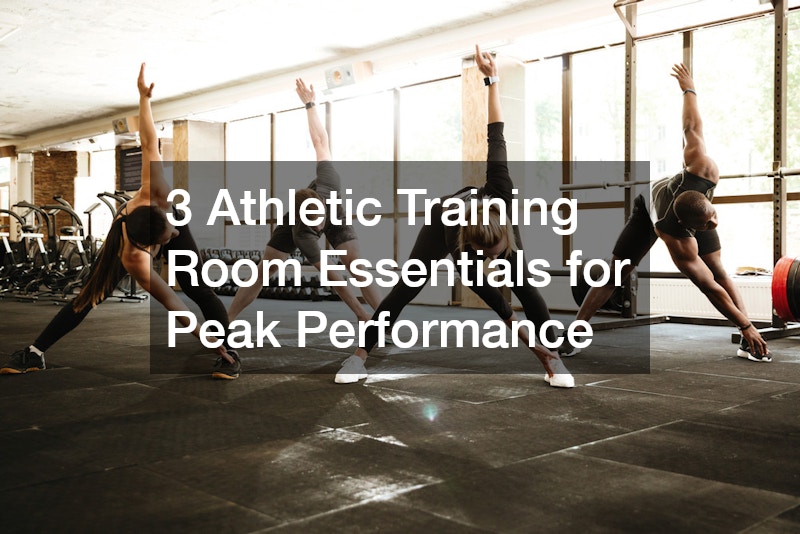
In the world of sports and physical training, the athletic training room is a sanctuary for athletes. It’s the place where players recover, rejuvenate, and prepare for their peak performance. But what are the essential components of an athletic training room that ensure athletes reach their full potential? This article aims to explore three key essentials that are vital for every athletic training room.
What Equipment is Essential in an Athletic Training Room?
Therapeutic and Preventive Tools
In any athletic training room, therapeutic and preventative tools are fundamental. Foam rollers help alleviate muscle tension, offering myofascial release, which is crucial for maintaining muscle flexibility and health. Resistance bands contribute to strength training and injury prevention by targeting specific muscle groups.
Heating pads serve an essential role in pain relief and muscle relaxation, particularly before workouts or rehabilitation sessions. Regular use of these tools can significantly improve performance and reduce injury risk for athletes. These essentials also support the maintenance of optimal physical condition, thus promoting sustainable practices in sports.
The strategic incorporation of these therapeutic and preventative tools transforms the athletic training room into a proactive environment. By prioritizing these tools, trainers can better prepare athletes for the demands of their sport. Ultimately, this results in a more resilient and capable athletic cohort.
Rehabilitation and Mobility Equipment
Rehabilitation and mobility equipment are indispensable for any athletic training room dedicated to recovery and performance enhancement. Balance boards, for instance, are crucial for improving stability and coordination, which are foundational to athletic competence. Exercise balls offer versatile resistance work, balance practice, and core strength exercises, which are beneficial for restoring physical capabilities.
Stretching straps assist in enhancing flexibility, offering athletes controlled stretching to prevent injuries and aid in recovery. Implementing these tools encourages consistent rehabilitation and mobility improvements for a range of conditions. By promoting a comprehensive approach to recovery, athletes are better equipped for competitive challenges.
Each piece of equipment serves a unique purpose in the athletic training room, enabling targeted recovery and performance strategies. When combined, these tools can significantly boost an athlete’s ability to recover from strenuous activity. In doing so, they ensure that training is both productive and safe for every individual involved.
How Can an Athletic Training Room Improve Recovery?
Injury Evaluation and Treatment
The process of injury evaluation and treatment is a critical function of the athletic training room. Professional evaluations provide a comprehensive understanding of the athlete’s condition, allowing for tailored recovery programs. Such personalized plans are crucial for efficient rehabilitation and preventing future injuries.
Diagnostic tools and skilled trainers in the room can identify specific issues and devise appropriate interventions. This attention to detail ensures that athletes are not only treated but also supported to enhance their overall health and performance. It also fosters an environment of trust, where athletes feel secure in divulging their concerns.
Effective injury evaluation leads to structured and strategic treatment plans, positively impacting the athlete’s long-term health. This level of care ensures athletes return to their sport stronger and more resilient, minimizing downtime. Ultimately, these practices are the backbone of a productive athletic training room, devoted to sustained athletic success.
Why is Space Design Important in Athletic Training Rooms?
Functional Layout Considerations
Designing an athletic training room with a functional layout is key to ensuring an effective training environment. The layout should consider the flow of movement and easy access to essential equipment, allowing for efficient use of space. Prioritizing multifunctional, open areas can accommodate a range of exercises and recovery protocols seamlessly.
By implementing ergonomic principles, the space can cater to the trainee’s changing needs, highlighting areas for strength, rehabilitation, and medical evaluation. A well-organized layout not only enhances the usability of the training room but also reduces clutter and maximizes safety. This strategic use of space embodies the essence of efficient athletic preparation and recovery.
Safety and Accessibility Standards
Adhering to rigorous safety and accessibility standards is a non-negotiable aspect of athletic training room design. Ensuring all equipment is securely stored and accessible can prevent accidents and facilitate a safe training environment. Compliance with accessibility standards ensures that all athletes, regardless of ability, can use the facilities effectively.
Installing nonslip flooring and providing clear signage enhances safety and navigability within the training room. Additionally, regular safety audits should be performed to maintain high standards and address potential risks promptly. These practices not only protect athletes but also reinforce confidence in the safety measures in place.
Prioritizing safety within the athletic training room ultimately fosters an inclusive and secure environment. With these standards in place, athletes can focus entirely on their training and recovery without fear of injury. Ensuring safety is integral to the room’s design and serves as a foundation for successful athletic pursuits.
Having the right equipment, recovery methodologies, and space design are foundational to optimizing performance in an athletic training room. Integrating these essentials not only enhances athletic performance but also minimizes injury risk, maximizes recovery, and ensures athletes are physically and mentally prepared for their sport. Whether setting up a new facility or revamping an existing one, these considerations are critical to achieving peak performance.

